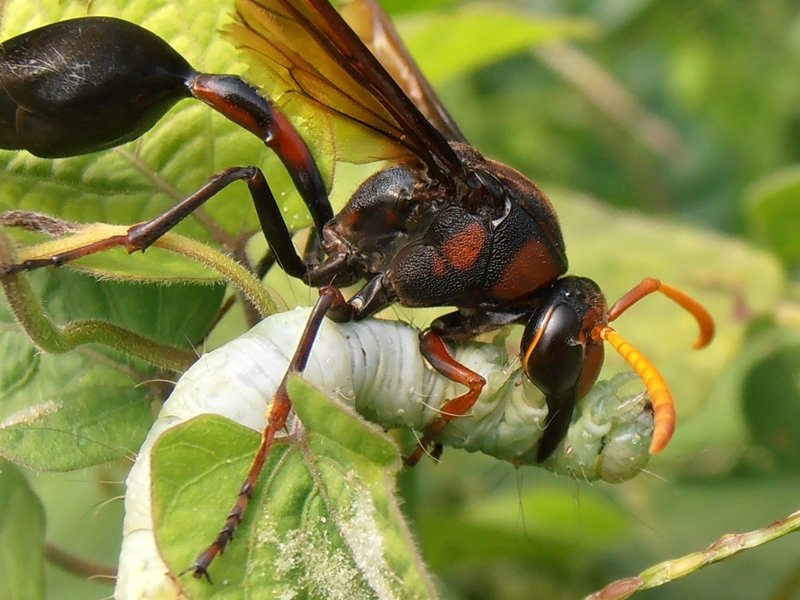Introduction
Parasitoid, a word we should all be familiar with, but one needs to understand the term parasite first. Parasite, An organism that lives inside another species’ organism is said to be a parasite. The parasite afterwards takes advantage of its host by drawing nutrients from it. It’s unsettling to think that parasites can be found anywhere, even inside our bodies. Although some of these parasites are not particularly dangerous, others can be fatal. Roundworms are probably one of the most prevalent instances. This tiny but deadly organism attaches itself to the host’s intestine like a leech and then suckers blood. They infect the intestines, which can lead to gastrointestinal problems in their prey and possibly anemia from blood loss. Unlike parasites, which rely on their hosts for their survival, parasitoids typically kill their hosts in order to complete their development.

The natural enemies of caterpillar.
A parasitoid is a type of organism that lives on or inside another organism, ultimately killing it as part of its life cycle. Parasitoids are usually insects, although some species of wasps, flies, and even some types of nematodes can also be considered parasitoids. They lay their eggs on or inside the bodies of other insects, and the developing parasitoid larvae feed on their host’s body fluids or tissues, eventually causing the host’s death. they are important biological control agents in agriculture, as they can help to reduce the populations of pest insects. However, some parasitoids can also attack beneficial insects, so they must be carefully managed to ensure that they do not cause unintended harm. The wasp frequently finds a caterpillar to be an easy target. A caterpillar’s saliva draws the caterpillar’s natural predators when it eats on a plant. Possibly the worst threat to the caterpillar is a species of wasp called Cotesia Golmerata, a species of parasitoid wasp that is commonly used as a biological control agent to manage populations of caterpillar pests in agriculture. The female wasp lays its eggs inside the body of a caterpillar, and the developing wasp larvae feed on the caterpillar’s tissues, the caterpillar is rendered unconscious by a chemical released by the larvae, which subsequently emerge from the caterpillar and eventually begin to make golden silk. Knowing that the caterpillar is alive despite being in such an uncomfortable circumstance may sound horrifying and distressing.

Xenomorph and Parasitoid wasps
Often compared with a species of alien called the ‘Xenomorph’ known for their aggressive behavior, sharp claws, and elongated heads with an inner jaw that can protrude and attack their prey. Xenomorphs are a parasitic species that require a host organism to reproduce. They lay their eggs inside the body of a living creature, and when the embryo is fully grown bursts out of the host’s chest as a fully formed Xenomorph.
It may hurt, but the fact that a parasitoid wasp served as the inspiration for this film makes me feel both fascinated by nature and uneasy at the same time. The caterpillar stands guard over the wasps like a mother figure, keeping other insects at bay. The cycle is repeated as the caterpillar eventually perishes and the wasps emerge from the golden silk.
Conclusion
No matter how wonderful or repulsive something may appear, cannot deny the fact that parasites have taken over the world and there is a reason behind it. While this might seem like a negative relationship, parasitoidism plays an important role in many ecosystems. One of the primary benefits of parasitoidism is that it helps to control populations of other organisms, particularly insects. Another important benefit of parasitoidism is that it can promote biodiversity.
By controlling populations of certain species, parasitoids can help to prevent any one species from dominating an ecosystem. This can help to maintain a healthy balance of different species, which is important for the overall health of an ecosystem. Parasitoids can also help to promote evolutionary diversity. Because parasitoids are highly specialized to their host species, they can drive the evolution of their hosts by selecting for traits that make them less susceptible to parasitism. This can lead to the development of new species or subspecies, which can help to increase the overall diversity of an ecosystem. Overall, while parasitoids may seem like a negative relationship, it plays an important role in many ecosystems and helps to promote biodiversity and the health of the ecosystem as a whole.
parasitoid wasp and caterpillar
The natural enemies of caterpillar.
A parasitoid is a type of organism that lives on or inside another organism, ultimately killing it as part of its life cycle. Parasitoids are usually insects, although some species of wasps, flies, and even some types of nematodes can also be considered parasitoids. They lay their eggs on or inside the bodies of other insects, and the developing parasitoid larvae feed on their host’s body fluids or tissues, eventually causing the host’s death. they are important biological control agents in agriculture, as they can help to reduce the populations of pest insects. However, some parasitoids can also attack beneficial insects, so they must be carefully managed to ensure that they do not cause unintended harm. The wasp frequently finds a caterpillar to be an easy target. A caterpillar’s saliva draws the caterpillar’s natural predators when it eats on a plant. Possibly the worst threat to the caterpillar is a species of wasp called Cotesia Golmerata, a species of parasitoid wasp that is commonly used as a biological control agent to manage populations of caterpillar pests in agriculture. The female wasp lays its eggs inside the body of a caterpillar, and the developing wasp larvae feed on the caterpillar’s tissues, the caterpillar is rendered unconscious by a chemical released by the larvae, which subsequently emerge from the caterpillar and eventually begin to make golden silk. Knowing that the caterpillar is alive despite being in such an uncomfortable circumstance may sound horrifying and distressing.

Xenomorph and Parasitoid wasps
Often compared with a species of alien called the ‘Xenomorph’ known for their aggressive behavior, sharp claws, and elongated heads with an inner jaw that can protrude and attack their prey. Xenomorphs are a parasitic species that require a host organism to reproduce. They lay their eggs inside the body of a living creature, and when the embryo is fully grown bursts out of the host’s chest as a fully formed Xenomorph.
It may hurt, but the fact that a parasitoid wasp served as the inspiration for this film makes me feel both fascinated by nature and uneasy at the same time. The caterpillar stands guard over the wasps like a mother figure, keeping other insects at bay. The cycle is repeated as the caterpillar eventually perishes and the wasps emerge from the golden silk.
Conclusion
No matter how wonderful or repulsive something may appear, cannot deny the fact that parasites have taken over the world and there is a reason behind it. While this might seem like a negative relationship, parasitoidism plays an important role in many ecosystems. One of the primary benefits of parasitoidism is that it helps to control populations of other organisms, particularly insects. Another important benefit of parasitoidism is that it can promote biodiversity.
By controlling populations of certain species, parasitoids can help to prevent any one species from dominating an ecosystem. This can help to maintain a healthy balance of different species, which is important for the overall health of an ecosystem. Parasitoids can also help to promote evolutionary diversity. Because parasitoids are highly specialized to their host species, they can drive the evolution of their hosts by selecting for traits that make them less susceptible to parasitism. This can lead to the development of new species or subspecies, which can help to increase the overall diversity of an ecosystem. Overall, while parasitoids may seem like a negative relationship, it plays an important role in many ecosystems and helps to promote biodiversity and the health of the ecosystem as a whole.
Rank MathGeneral
The deadly parasitoid Trybe News
Parasitoid, a word we should all be familiar with, but one needs to understand the term parasite first. Parasite, An organism that lives inside another…Edit Snippet
Focus Keyword
parasitoid
Want more? Upgrade today to the PRO version.This post is Pillar Content
Basic SEOAll Good
- Hurray! You’re using Focus Keyword in the SEO Title.
- Focus Keyword used inside SEO Meta Description.
- Focus Keyword used in the URL.
- Focus Keyword appears in the first 10% of the content.
- Focus Keyword found in the content.
- Content is 741 words long. Good job!
Additional4 Errors
- Focus Keyword found in the



